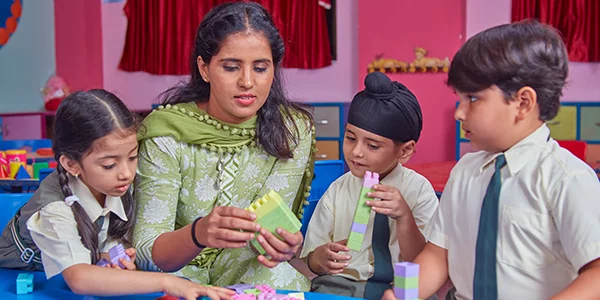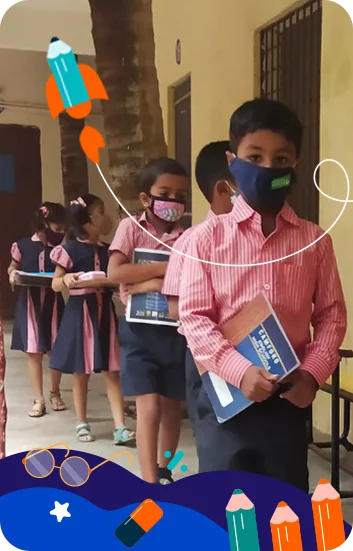How LEAD School is bringing all stakeholders together to create a welcoming virtual classroom for pre-primary children?
.png)
Give Your School The Lead Advantage
The lockdown and the subsequent school closures have led to the neglect of the developmental needs of children in the pre-primary stage. Children in this age group are experiencing rapid brain development but their potential is unlikely to be tapped unless their faculties are fully engaged. LEAD School has thus modified its integrated learning pedagogy to suit the virtual learning model and to ensure school readiness for these young children.
Every morning, four-year-old Vishal wakes up, full of enthusiasm, to take in what the day has to offer. He was slated to join kindergarten last June. However, the pandemic turned things upside down and like many other kids of his age, he remains at home. This inherently curious child explores everything around him and asks questions throughout the day. Unable to keep up with his inquisitiveness, his parents often shun his questions. His brother, who is 10, at least gets the chance to listen to his teachers and talk to his friends for a few hours during online classes. Vishal, however, is left behind because he is considered too young for these classes.
The pandemic has had a very adverse effect on children like Vishal who are in their formative years. The foundations of thought, behaviour, and emotions are laid during this developmental spurt, with the skills and interests picked up during this period lasting for a lifetime. Children are learning every day and all the time, by taking part in activities, by exploring, by interacting with others, and by asking questions in every setting they are in. It is thus imperative to keep the child engaged and provide a stimulating learning environment as the skills children of Vishal’s age group develop at this stage form the groundwork for future years of learning.
LEAD School’s integrated theme-based learning approach to pre-primary ensures holistic development of the child. In this approach, EVS, language, numeracy, and physical skills are not taught in isolation but integrated together based on seven EVS topics covered throughout the year. This the understanding of the child moves from self to world, known to unknown.

However, during this pandemic, we now must cater to an age group whose first schooling experience is online, a scenario that is very peculiar for not only young children but also parents and teachers. In the initial days of the lockdown, LEAD School rolled out a few online lessons for the pre-primary children. However, with the prolonged closure of schools, we needed sustainable solutions to ensure there is no learning loss for this age group. LEAD School thus focused on modifying the activities, ways of conducting worksheets and giving instructions to teach in an online setup. As the plug-and-play style does not work for early schoolers with short attention spans, the curriculum had to encompass a kindergartener’s need to move, explore, and play.
Fostering parent-teacher partnership
{% video_player “embed_player” overrideable=False, type=’scriptV4′, hide_playlist=True, viral_sharing=False, embed_button=False, autoplay=False, hidden_controls=False, loop=False, muted=False, full_width=False, width=’410′, height=’484′, player_id=’49877885571′, style=’max-width: 410px; margin: 6px 10px 10px 0px; width: 100%; display: block; float: left;’ %}
The task of addressing the needs of a kindergartener cannot be met without the support of parents, especially during the pandemic and online learning. LEAD School has always emphasised parent-teacher partnership. In the current scenario, we have the dual responsibility of addressing both the parent and child. Parents have the important responsibility of ensuring uninterrupted learning for the child and enhancing the child’s engagement. They are given complete guidance on carrying out all the learning goals assigned, including using household materials for activities, helping children with worksheets, and strategies to get children to read stories independently.
Thus, LEAD School’s integrated learning approach has been modified and evolved to suit the home environment. Considering their significant role in the process, we also provide a bilingual option for the parent to understand the instructions given. The adage ‘Home is the first school; parent is the first teacher’ is all the truer in this situation.
The importance of a routine
With the curriculum designed for their natural setting – the home – the next step is to help the children have a routine. A schedule that is predictable yet flexible helps both the parent and the child create a sense of order. This becomes especially crucial for the children when they transition from home to school.
Children are taught through playful inquiry. A typical class is divided into two segments of 30-35 minutes, each with clearly defined learning outcomes. Although the total duration of the class is around one hour, the child is meaningfully engaged for 3 to 3.5 hours with activities, reading time and solving worksheets after their online class. Parents are briefed on the activities of the day and given guidance on conducting them. Considering the children’s fleeting attention spans, small activities are demonstrated for 5-7 minutes. This helps the child participate in the class and interact with the teachers.
A holistic curriculum

For instance, a theme-based curriculum is followed for EVS. Every month, the child is introduced to a new theme and this has been shown to heighten retention. Children develop long-term memory of the topic because they learn the concepts in context. Study topics in EVS slowly unfold from the self to the world. Prior to the second wave, children were encouraged to visit their neighbourhood to forge stronger connections with the world around them.
Similarly, children spend 20 minutes a day with literacy and phonics activities. Our audio-visual aids have been immensely useful, and these brief daily sessions have led to students showing remarkable progress in becoming independent readers.
When it comes to developing numeracy skills, the Concrete-Pictorial-Abstract approach has proved very effective in several of our partner schools. Children discover math using relevant contexts and everyday experiences. Something as simple as counting objects in the house goes a long way in strengthening these skills, as opposed to rote learning.
{% video_player “embed_player” overrideable=False, type=’scriptV4′, hide_playlist=True, viral_sharing=False, embed_button=False, autoplay=False, hidden_controls=False, loop=False, muted=False, full_width=False, width=’410′, height=’437′, player_id=’49877786294′, style=’max-width: 410px; margin: 6px 10px 10px 0px; width: 100%; display: block; float: left;’ %}
Another key area of focus, especially in the absence of a physical classroom and space to move, is the child’s gross and fine motor skills and dexterity. Once again, we identified routine activities the child could do at home for fine motor skill development. For example, children were made to fill pulses in a jar. Although a straightforward task, it has phenomenal effects on enhancing dexterity. Apart from activities involving climbing, jumping, and free play, we also introduce a yoga asana every week in a playful way to improve gross motor development. This has also helped enhance body awareness and coordination in children.
These are just a few examples of how a holistic curriculum has been developed in which each subject and each lesson is connected to each other, and is part of a grand whole. Topics are repeatedly reinforced across multiple contexts, helping them remember what was taught.
This approach to pre-school learning has not only successfully engaged children but also made parents much more involved and invested in their children’s education. In fact, the crisis of the pandemic could even become an opportunity to enhance parental support for their children’s education and even foster good relationships in the family. These might go a long way in bridging skill gaps that come from students not having access to classrooms at this crucial time.
LEAD School’s versatile curriculum ensures that children have so much more than a mere screen to aid their learning at perhaps the most important stage of their development. What is better, a holistic curriculum for pre-primary kids does not even require sophisticated resources and learning from home can be organic, exciting, and fun. All the stakeholders have risen to the occasion to build an effective home-learning team and plan to eventually help children transition into school with no learning gap. With LEAD School’s virtual curriculum, a child-like Vishal will find his curiosity nurtured, his energy channelised, and his skills school-ready ahead of a lifetime of learning.
LEAD is transforming schools by making children future-ready. To make yours a LEAD Powered School: Partner with us today

